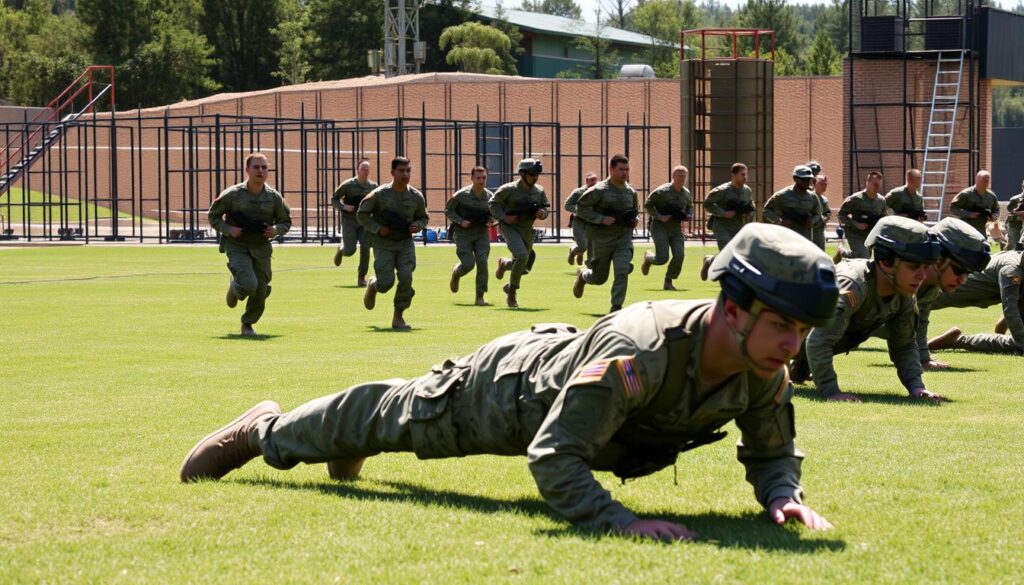Physical readiness isn’t just a box to check—it’s the backbone of military effectiveness. While many focus on strength training or endurance runs, there’s one critical tool that quietly determines career longevity: the Army’s standardized method for tracking body composition.
Meeting service requirements starts with accurate measurements. A soldier’s height and weight directly impact their ability to perform duties, access promotions, and maintain eligibility for specialized roles. Yet, inconsistent tracking can lead to unexpected setbacks.
This guide explains why regular self-assessment matters far beyond basic compliance. We’ll break down how these calculations work, their role in career planning, and practical steps to stay ahead of standards. Because when it comes to military readiness, precision isn’t optional—it’s mission-critical.
Key Takeaways
- Body composition directly impacts military career opportunities and operational readiness
- Standardized tools provide objective data for fitness evaluations
- Regular self-checks prevent last-minute surprises during official assessments
- Accurate measurements support long-term health and performance goals
- Understanding calculation methods helps maintain compliance effortlessly
Overview of Army Height and Weight Standards
Meeting physical benchmarks isn’t about arbitrary rules—it’s about ensuring every service member can perform at their best. The military uses precise metrics to balance operational demands with individual health needs.
Understanding the Physical Requirements
Body composition standards are rooted in decades of medical research. They account for factors like age and muscle mass while prioritizing cardiovascular health. For example, a 25-year-old soldier might have different BMI thresholds than someone a decade older.
These requirements exist for two reasons: safety during missions and long-term career sustainability. Excess body fat can limit mobility, while insufficient muscle mass reduces endurance. Balance is key.
“Body fat percentages aren’t just numbers—they’re predictors of battlefield effectiveness.”
The Role of Calculators in Assessing Fitness
Modern tools simplify complex health evaluations. Specialized calculators use Department of Defense formulas to analyze:
- Height-to-weight ratios
- Body fat distribution
- Age-adjusted benchmarks
| Age Group | BMI Range | Max Body Fat % |
|---|---|---|
| 17-20 | 18.5-25 | 20% |
| 21-27 | 19-26 | 22% |
| 28+ | 20-27.5 | 24% |
Regular self-checks using these tools help service members stay ahead of official assessments. They transform vague fitness goals into actionable data points. When paired with nutrition plans, this approach builds sustainable health habits.
How often should soldiers verify their stats with the Army Height Calculator?
Consistent monitoring bridges the gap between fitness efforts and military requirements. By establishing smart check-in habits, service members gain control over their physical readiness long before formal evaluations occur.
Smart Scheduling for Reliable Results
We recommend monthly self-assessments using approved measurement tools. This cadence catches gradual changes in body fat percentages before they become problematic. Those adjusting workout routines or meal plans should increase checks to every 2-3 weeks.
Key moments demand extra attention:
- 30-60 days before scheduled fitness tests
- After extended leave or recovery periods
- When changing climate zones or operational environments
Advantages of Proactive Tracking
Regular measurements transform guesswork into strategy. They reveal how training adaptations affect overall health, allowing timely tweaks to nutrition or exercise regimens. This approach helps maintain a healthy weight without drastic last-minute measures.
“Proactive tracking turns compliance into strategy.” – Military Fitness Expert
Three critical benefits emerge from disciplined monitoring:
- Early detection of body composition shifts
- Alignment between personal goals and unit requirements
- Reduced anxiety during official evaluations
By treating measurements as mission-critical information, service members create a sustainable way to meet standards while optimizing their physical potential. This disciplined habit supports both career progression and battlefield effectiveness.
Interpreting Your Height, Weight, and Body Composition Data
Understanding your physical metrics goes beyond numbers—it’s about strategic readiness. Let’s break down what your measurements mean and how they connect to mission success.
Decoding BMI and Body Fat Percentages
BMI measures weight relative to height, but it’s just the starting point. Military standards pair this with body fat percentage to account for muscle mass. A BMI of 25 might signal excess fat for one soldier, while indicating peak conditioning for another.
| BMI Category | Body Fat Range | Action Required |
|---|---|---|
| 18.5-24.9 | 10-20% | Optimal range |
| 25-29.9 | 21-24% | Monitor nutrition |
| 30+ | 25%+ | Fitness intervention |
Body composition tells the real story. Those with higher muscle mass often show elevated BMI but lower fat percentages. This distinction determines whether you’re cleared for airborne operations or need adjusted training plans.
Using Online Tools Effectively
Modern platforms simplify complex calculations. Input your measurements to get instant comparisons against military benchmarks. Look for tools that:
- Update with current DoD formulas
- Show visual progress charts
- Offer personalized improvement tips
One sergeant shared:
“Seeing my fat percentage drop 2% after adjusting meal timing helped me ace my last assessment.”
Regular tool use turns raw data into actionable insights. Pair your numbers with performance reviews to identify patterns. Does higher body fat correlate with slower run times? Use these connections to refine your fitness strategy.
Preparing for the Army’s Physical Assessment
Success in military assessments starts long before test day—it’s built through daily discipline. Tailored nutrition and training plans create sustainable pathways to meet weight requirements while enhancing combat readiness. Let’s explore how to build routines that stick.
Fueling Performance Through Smart Nutrition
Military physical condition thrives on balanced meals timed for energy needs. Men typically require 500+ extra calories daily for muscle maintenance, while women benefit from iron-rich foods to support endurance. Consider these meal planning essentials:
- Protein-focused breakfasts for sustained energy
- Hydration protocols matching activity levels
- Portion control strategies during field exercises
Adapting Training to Individual Needs
Effective exercise programs address gender-specific strengths. Women often excel in flexibility drills, while men may prioritize load-bearing capacity. This table shows common focus areas:
| Gender | Primary Focus | Secondary Focus |
|---|---|---|
| Men | Upper-body strength | Agility drills |
| Women | Core stability | Speed training |
“Routine tests reveal what’s working—and what needs tweaking.”
Monthly progress checks using the Army’s standardized tools help maintain alignment with service standards. Adjust workout intensity if body fat drops too rapidly, or energy levels dip during drills.
Consistent tracking turns guesswork into actionable insights. Pair measurement data with performance reviews to spot trends. Does improved run time correlate with better sleep patterns? Use these connections to refine your approach.
Exploring Exceptions and Adjustments in Army Physical Standards
Military requirements evolve to match real-world needs. While standards exist for safety and performance, strategic exceptions maintain operational flexibility without compromising readiness.
When Flexibility Supports Mission Success
Waivers aren’t loopholes—they’re tools for exceptional cases. Temporary allowances might apply for:
- Medical recoveries requiring modified training
- Specialized roles needing unique physiques
- Hormonal conditions affecting body mass
Approval depends on mass index trends and performance metrics. A staff sergeant shared:
“My waist measurement waiver let me finish airborne training after injury rehab.”
Branch-Specific Approaches
Each service tailors its criteria. The air force often prioritizes aerobic capacity over pure strength, while combat roles demand higher muscle ratios. This table shows key differences:
| Branch | Focus Area | Max Fat Percentage |
|---|---|---|
| Army | Endurance | 24% |
| Air Force | Cardiovascular | 22% |
Gender also plays a role. Women often receive adjusted benchmarks for hip-to-waist ratios due to natural physiological variations.
Monthly progress reviews ensure soldiers stay aligned with adjusted targets. Combined with performance tests, these checks maintain accountability while honoring individual circumstances.
Conclusion
Maintaining peak physical condition requires more than raw effort—it demands precision. Our guide highlights why consistent tracking forms the foundation of military readiness. Regular check-ins transform fitness goals into achievable milestones while preventing career disruptions.
Body composition standards aren’t static. They adapt to age, gender, and mission requirements. Staying within optimal ranges ensures eligibility for promotions and specialized roles. Tools like the BMI calculator for men provide clarity for accurate health assessments.
Three principles drive long-term success:
- Proactive monitoring catches subtle changes before official evaluations
- Nutrition and training plans tailored to individual needs
- Understanding how benchmarks may shift over time
We’ve outlined strategies to help service members stay ahead of requirements. By treating physical readiness as a continuous process, you’ll build resilience for every challenge. Your commitment today shapes tomorrow’s opportunities.
FAQ
What happens if a soldier’s body composition doesn’t meet military weight standards?
If body fat percentage or BMI exceeds limits, soldiers may enter a monitored fitness program. Regular assessments and tailored training plans help them regain compliance while prioritizing overall health.
How do BMI and body fat percentage differ in assessing physical condition?
BMI measures mass-to-height ratios but doesn’t distinguish muscle from fat. Body fat percentage offers a clearer picture of composition, which is why the Army uses both to evaluate fitness accurately.
Are online calculators reliable for tracking body fat and weight requirements?
While tools like the Army Height Calculator provide helpful estimates, they’re supplements—not replacements—for official assessments. We recommend combining them with in-person evaluations for precise tracking.
What nutrition strategies support meeting Army physical fitness goals?
Focus on balanced meals rich in protein, complex carbs, and healthy fats. Hydration and portion control also play key roles. Pairing nutrition with consistent exercise ensures steady progress toward body composition targets.
Do weight standards vary between the Army and other branches like the Air Force?
Yes. Each branch sets slightly different thresholds based on mission demands. For example, the Air Force may adjust allowances for roles requiring specialized physical performance.
Can soldiers request waivers for body fat percentage exceptions?
In some cases, waivers are granted for temporary medical conditions or unique circumstances. However, maintaining standards remains critical, so exceptions are evaluated carefully to ensure readiness.
Why is tracking progress between assessments important?
Regular self-checks help identify trends early, allowing adjustments to training or nutrition before official tests. This proactive approach reduces last-minute stress and supports long-term fitness success.


